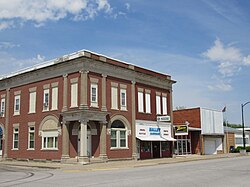Demographics
Historical populations| Year | | |
|---|
| 1880 | 710 | — |
|---|
| 1890 | 777 | +9.4% |
|---|
| 1900 | 996 | +28.2% |
|---|
| 1910 | 988 | −0.8% |
|---|
| 1920 | 1,025 | +3.7% |
|---|
| 1930 | 955 | −6.8% |
|---|
| 1940 | 1,032 | +8.1% |
|---|
| 1950 | 1,145 | +10.9% |
|---|
| 1960 | 1,096 | −4.3% |
|---|
| 1970 | 1,112 | +1.5% |
|---|
| 1980 | 1,034 | −7.0% |
|---|
| 1990 | 1,000 | −3.3% |
|---|
| 2000 | 1,025 | +2.5% |
|---|
| 2010 | 1,009 | −1.6% |
|---|
| 2020 | 897 | −11.1% |
|---|
Source: "American FactFinder". United States Census Bureau. Archived from the original on February 12, 2020. Retrieved March 29, 2020. and Iowa Data Center
Source: |
2020 census
As of the census of 2020, [11] there were 897 people, 384 households, and 239 families residing in the city. The population density was 1,159.9 inhabitants per square mile (447.8/km2). There were 422 housing units at an average density of 545.7 per square mile (210.7/km2). The racial makeup of the city was 94.9% White, 0.9% Black or African American, 0.1% Native American, 0.0% Asian, 0.0% Pacific Islander, 0.7% from other races and 3.5% from two or more races. Hispanic or Latino persons of any race comprised 3.2% of the population.
Of the 384 households, 30.7% of which had children under the age of 18 living with them, 45.1% were married couples living together, 6.2% were cohabitating couples, 27.6% had a female householder with no spouse or partner present and 21.1% had a male householder with no spouse or partner present. 37.8% of all households were non-families. 33.3% of all households were made up of individuals, 17.7% had someone living alone who was 65 years old or older.
The median age in the city was 42.4 years. 27.6% of the residents were under the age of 20; 4.3% were between the ages of 20 and 24; 21.4% were from 25 and 44; 25.4% were from 45 and 64; and 21.2% were 65 years of age or older. The gender makeup of the city was 49.4% male and 50.6% female.
2010 census
As of the census [12] of 2010, there were 1,009 people, 408 households, and 269 families living in the city. The population density was 1,601.6 inhabitants per square mile (618.4/km2). There were 443 housing units at an average density of 703.2 per square mile (271.5/km2). The racial makeup of the city was 98.3% White, 0.4% African American, 0.2% Asian, and 1.1% from two or more races. Hispanic or Latino of any race were 0.2% of the population.
There were 408 households, of which 32.4% had children under the age of 18 living with them, 50.7% were married couples living together, 10.5% had a female householder with no husband present, 4.7% had a male householder with no wife present, and 34.1% were non-families. 30.9% of all households were made up of individuals, and 13.9% had someone living alone who was 65 years of age or older. The average household size was 2.40 and the average family size was 2.95.
The median age in the city was 40.5 years. 26.4% of residents were under the age of 18; 5.4% were between the ages of 18 and 24; 22.5% were from 25 to 44; 28.3% were from 45 to 64; and 17.3% were 65 years of age or older. The gender makeup of the city was 49.7% male and 50.3% female.
2000 census
As of the census [13] of 2000, there were 1,025 people, 430 households, and 258 families living in the city. The population density was 1,636.9 inhabitants per square mile (632.0/km2). There were 466 housing units at an average density of 744.2 per square mile (287.3/km2). The racial makeup of the city was 98.73% White, 0.29% Native American, 0.49% Asian, 0.39% from other races, and 0.10% from two or more races. Hispanic or Latino of any race were 0.59% of the population.
There were 430 households, out of which 27.7% had children under the age of 18 living with them, 49.1% were married couples living together, 6.7% had a female householder with no husband present, and 39.8% were non-families. 35.6% of all households were made up of individuals, and 21.6% had someone living alone who was 65 years of age or older. The average household size was 2.28 and the average family size was 2.98.
In the city, the population was spread out, with 23.3% under the age of 18, 7.5% from 18 to 24, 25.3% from 25 to 44, 19.9% from 45 to 64, and 24.0% who were 65 years of age or older. The median age was 41 years. For every 100 females, there were 86.0 males. For every 100 females age 18 and over, there were 84.9 males.
The median income for a household in the city was $35,966, and the median income for a family was $43,393. Males had a median income of $30,481 versus $24,479 for females. The per capita income for the city was $17,310. About 7.6% of families and 8.8% of the population were below the poverty line, including 11.7% of those under age 18 and 7.7% of those age 65 or over.
This page is based on this
Wikipedia article Text is available under the
CC BY-SA 4.0 license; additional terms may apply.
Images, videos and audio are available under their respective licenses.



